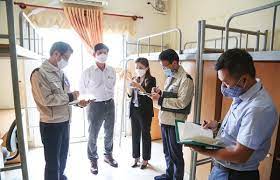
 |
| Industrial zones are urged to organise the isolation of suspected COVID-19 cases to ensure smooth operations |
Amata Group, the developer in Amata Bien Hoa Industrial Park, has spent over $130,000 transforming one facility into a temporary isolation place for F1 and F0 coronavirus cases detected through the rapid test method.
Covering an area of 1,500 square metres with 200 spare beds, the temporary isolation area is equipped with full facilities for daily living and emergency equipment such as oxygen bottles and monitoring machines.
The park is a manufacturing hub for 170 multinational manufacturing companies with a workforce of more than 60,000 people. Thus, Amata’s leaders decided to focus on ensuring production safety and supporting its customers.
Nguyen Van Danh, deputy head of Dong Nai Industrial Zones Management Authority (DIZA), said Amata’s case sets a strong example for industrial zone (IZ) developers in supporting enterprises to maintain stable operations. To date, 31 such IZs in the province have resumed operations, and 29 of them have arranged temporary isolation areas for workers infected with COVID-19.
According to Danh, the temporary areas are renovated from facilities, offices, and technical housing and cover a total area of more than 87,000sq.m and capacity of over 10,000 beds. Employees who are detected to have COVID-19 infection after rapid testing can be placed in temporary isolation areas while waiting for healthcare authorities to take them for treatment.
Statistics from the DIZA show that to date, approximately 1,660 of the total 1,700 enterprises in the province’s IZ resumed operations and 525,000 employees have returned to work (equalling 86 per cent) after nearly three months of social distancing.
“Having new COVID-19 cases in IZs when enterprises resume operation is understandable but we are determined to stay safe during the pandemic, and the most importance is to limit its spread,” Danh said. “Almost all employees live in rented houses with their families, thus the risk of community transmission is high. Maintaining temporary isolation areas in IZs is necessary because it helps businesses isolate cases, avoiding confusion for workers and some operation disruption.”
The strategy to build temporary isolation areas has reached other localities, including Ho Chi Minh City. Earlier this month, Saigon High-tech Park (SHTP) officially started to operate its own areas and received workers who have mild symptoms or are asymptomatic with underlying diseases. It also aided people who are not eligible for self-isolation at home.
Le Thi Bich Loan, deputy manager of SHTP, said that the first facility has a scale of 100 beds, fully equipped with essential utilities such as televisions, refrigerators, Wi-Fi, and gym rooms.
A second facility located in Linh Trung Export Processing Zone 2 in Thu Duc, with 250 beds, is also being installed. The management board of SHTP has plans to establish a third facility in another IZ located in Cu Chi district, with up to 300 more beds.
“This is a non-profit activity and does not use the state budget. Entire costs for establishing facilities and installing equipment and machinery are contributed by enterprises in SHTP in order to take care of employees and ensure stable operation,” Loan said.





